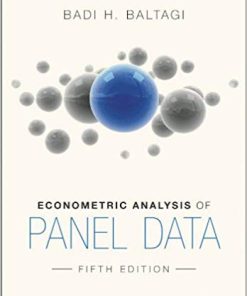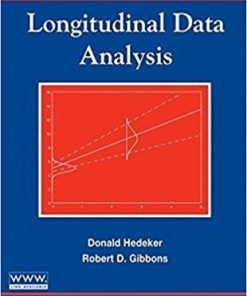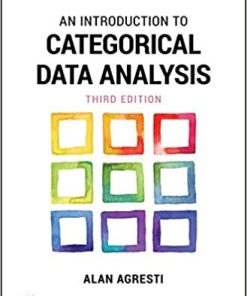Longitudinal Data Analysis by Donald Hedeker
$50.00 Original price was: $50.00.$35.00Current price is: $35.00.
Longitudinal Data Analysis by Donald Hedeker – Instant Download
Longitudinal Data Analysis by Donald Hedeker – Digital Ebook – Instant Delivery Download

Product details:
- ISBN-10 : 9780471420279
- ISBN-13 : 978-0471420279
- Author: Donald Hedeker, Robert D. Gibbons
Practical in their approach, the authors emphasize the applications of the methods, using real-world examples for illustration. Some syntax examples are provided, although the authors do not generally focus on software in this book. Several datasets and computer syntax examples are posted on this title’s companion Web site. The authors intend to keep the syntax examples current as new versions of the software programs emerge.
This text is designed for both undergraduate and graduate courses in longitudinal data analysis. Instructors can take advantage of overheads and additional course materials available online for adopters. Applied statisticians in biomedicine and the social sciences can also use the book as a convenient reference.
Table contents:
1. Introduction.
1.1 Advantages of Longitudinal Studies.
1.2 Challenges of Longitudinal Data Analysis.
1.3 Some General Notation.
1.4 Data Layout.
1.5 Analysis Considerations.
1.6 General Approaches.
1.7 The Simplest Longitudinal Analysis.
1.8 Summary.
2. ANOVA Approaches to Longitudinal Data.
2.1Single-Sample Repeated Measures ANOVA.
2.2 Multiple-Sample Repeated Measures ANOVA.
2.3 Illustration.
2.4 Summary.
3. MANOVA Approaches to Longitudinal Data.
3.1 Data Layout for ANOVA versus MANOVA.
3.2 MANOVA for Repeated Measurements.
3.3 MANOVA of Repeated Measures-s Sample Case.
3.4 Illustration.
3.5 Summary.
4. Mixed-Effects Regression Models for Continuous Outcomes.
4.1 Introduction.
4.2 A Simple Linear Regression Model.
4.3 Random Intercept MRM.
4.4 Random Intercept and Trend MRM.
4.5 Matrix Formulation.
4.6 Estimation .
4.7 Summary.
5. Mixed-Effects Polynomial Regression Models.
5.1 Introduction.
5.2 Curvilinear Trend Model.
5.3 Orthogonal Polynomials.
5.4 Summary.
6. Covariance Pattern Models.
6.1 Introduction.
6.2 Covariance Pattern Models.
6.3 Model Selection.
6.4 Example.
6.5 Summary.
7. Mixed Regression Models with Autocorrelated Errors.
7.1 Introduction.
7.2 MRMs with AC Errors.
7.3 Model Selection.
7.4 Example.
7.5 Summary.
8. Generalized Estimating Equations (GEE) Models.
8.1 Introduction.
8.2 Generalized Linear Models (GLMs).
8.3 Generalized Estimating Equations (GEE) Models.
8.4 GEE Estimation.
8.5 Example.
8.6 Summary.
9. Mixed-Effects Regression Models for Binary Outcomes.
9.1 Introduction.
9.2 Logistic Regression Model.
9.3 Probit Regression Models.
9.4 Threshold Concept.
9.5 Mixed-Effects Logistic Regression Model.
9.6 Estimation.
9.7 Illustration.
9.8 Summary.
10. Mixed-Effects Regression Models for Ordinal Outcomes.
10.1 Introduction.
10.2 Mixed-Effects Proportional Odds Model.
10.3 Psychiatric Example.
10.4 Health Services Research Example.
10.5 Summary.
11. Mixed-Effects Regression Models for Nominal Data.
11.1 Mixed-Effects Multinomial Regression Model.
11.2 Health Services Research Example.
1 1.3 Competing Risk Survival Models.
11.4 Summary.
12. Mixed-effects Regression Models for Counts.
12.1 Poisson Regression Model.
12.2 Modified Poisson Models.
12.3 The ZIP Model.
12.4 Mixed-Effects Models for Counts.
12.5 Illustration.
12.6 Summary.
13. Mixed-Effects Regression Models for Three-Level Data.
13.1 Three-Level Mixed-Effects Linear Regression Model.
13.1.1 Illustration.
13.2 Three-Level Mixed-Effects Nonlinear Regression Models.
13.3 Summary.
14. Missing Data in Longitudinal Studies.
14.1 Introduction.
14.2 Missing Data Mechanisms.
14.3 Models and Missing Data Mechanisms.
14.4 Testing MCAR.
14.5 Models for Nonignorable Missingness.
14.6 Summary.
Bibliography.
Topic Index.
People also search:
longitudinal data analysis in r
applied longitudinal data analysis
constrained longitudinal data analysis
longitudinal data analysis methods
time-varying covariates longitudinal data analysis
You may also like…
Computers - Organization and Data Processing
Biology and Microbiology
(eBook PDF) Bioinformatics and Data Analysis in Microbiology











